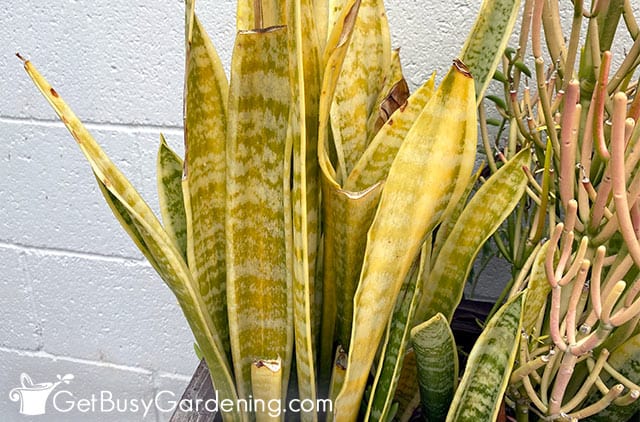Snake Plant Leaves Turning Yellow Things To Know Before You Buy
Snake Plant Leaves Turning Yellow Can Be Fun For Everyone
Table of ContentsSnake Plant Leaves Turning Yellow - QuestionsThe Only Guide for Snake Plant Leaves Turning YellowThe Ultimate Guide To Snake Plant Leaves Turning YellowThe Best Guide To Snake Plant Leaves Turning YellowNot known Factual Statements About Snake Plant Leaves Turning Yellow The Single Strategy To Use For Snake Plant Leaves Turning Yellow
The majority of signs of origin rot aren't noticeable to the exterior of a plant, besides one indicator yellowing leaves. When a snake plant has yellow leaves, this is commonly an indicator of overwatering leading to origin rot. Snake Plant Leaves Turning Yellow. When yellow, the fallen leave is basically dead because it's not getting any kind of nutrients from the decomposed rootsThe very best method to examine if the plant needs watering is to stick your finger one inch into the soil. If the soil is wet, you do not need to water it. If the dirt is bone completely dry, it's time to sprinkle the plant. Snake plants in fact work best in dryer problems than damp ones, so you need to only water your snake plant when every 7-10 days.
Rather, the natural sunshine should be indirect. This indicates that if your snake plant remains on a windowsill or surface area that is continuously in the sunlight, this is most likely the reason of the yellowing fallen leaves. Yellow leaves imply that the plant is burning from the sunlight, which after that at some point transforms brownish and crispy.
Some Ideas on Snake Plant Leaves Turning Yellow You Should Know
The sunshine will then concentrate on particular parts of the fallen leaves, resulting in burnt leaves. House plants call for consistency to thrive.
Any sudden changes in these needs, specifically the temperature level, can lead to the stress and anxiety of a plant. That's best tension from radical changes in temperature leads to yellow fallen leaves. The primary factor to avoid placing your serpent plant with continuous temperature level modifications is that it totally influences the dissipation procedure.

Snake Plant Leaves Turning Yellow Can Be Fun For Anyone
When over-fertilized, the plant food will certainly do one of two things. It will either shed the fallen leaves, causing them to transform yellow, or it will soak up too much moisture from the soil. This will certainly protect against the plant from absorbing the moisture it needs to make it through, which essentially causes a useful reference dried plant.
If you think you might have over-fertilized your snake plant, it's best to leave the plant alone for a few weeks to months.

The Ultimate Guide To Snake Plant Leaves Turning Yellow
I have actually seen my share of obstacles with the tough Serpent Plant, consisting of the strange yellowing of leaves. Actually, our great intentions can in some cases injure our Snake Plant kingdoms.
: If the dirt is dry, repeat the process. Believe it or otherwise, also our sturdy Serpent Plants lack their nutritional supply after some time. When you first acquire your Serpent Plant, it features a decent amount of nutrients in its potting mix. However with time, like any kind of other houseplant, it tires this supply.
Right here's a convenient overview for you: from my response the pot. for indications of fungus. using sterile pruning shears. to the origins to stop future fungal development. For an extra thorough overview on repotting, have a look at our article on Serpent Plant kingdom are exotic citizens, and they like their temperature level steady and cozy.
Snake Plant Leaves Turning Yellow Things To Know Before You Get This
Icing up temperature levels can harm the fallen leaves, and heats or heatwaves can speed up water loss and damage the healthy proteins holding chlorophyll. When these proteins are damaged, chlorophyll decreases, and the fallen leaves transform yellow. To treat this, guarantee your Serpent Plant is positioned in an area in your house with even more regular temperatures.
The service is basic: change your Serpent Plant to a pot with ample drainage holes. In my experience, the kind of dirt you make use of for your serpent plant is essential.
Also the sun-loving serpent plant has its limits. Prolonged direct exposure to direct sunlight problems the cells of the leaves, bring about. It's the plant's method of claiming it's had a little bit excessive sun! To alleviate this, relocate your snake plant to an area with. Your snake straight from the source plant will thank you for it.
The Basic Principles Of Snake Plant Leaves Turning Yellow

Insects and fungal infections can suck the sap from the leaves, robbing the snake plant of nutrients and causing the fallen leaves to transform yellow. Apply to manage the pests and fungal infections.
Snake plant leaves are prone to yellowing if the plant is not well took care of. The yellowing typically represents something is wrong with the watering and various other care techniques. What causes the yellowing, and just how do I fix it? Healthy serpent plants have a yellow tinting around the edges of their broad, vertical leaf blades.